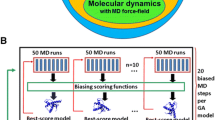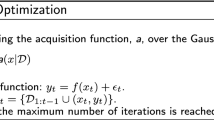Summary
A new NMR refinement method, FINGAR (FIt NMR using a Genetic AlgoRithm), has been developed, which allows one to determine a weighted set of structures that best fits measured NMR-derived data. This method shows appreciable advantages over commonly used refinement methods. FINGAR generates an ensemble of conformations whose average reproduces the experimental NMR-derived restraints. In addition, a statistical importance weight is assigned to each of the conformations in the ensemble. As a result, one is not limited to simply presenting an envelope of sampled conformers. Instead, one can subsequently focus on a select few conformers of high weight. This is critical, because many structural analyses depend on using discrete conformations, not simply averages or ensembles. The genetic algorithm used by FINGAR allows one to simultaneously and reliably fit against many restraints, and to generate solutions which include as many conformations with non-zero weights as are necessary to generate the best fit. An added benefit of FINGAR is that because the time-consuming step in this method needs only to be performed once, in the beginning of the first run, numerous FINGAR simulations can be performed rapidly.
Similar content being viewed by others
References
AltonaC. and SundaralingamM. (1972) J. Am. Chem. Soc., 94, 8205–8212.
AtkinsP.W. (1990) Physical Chemistry, Freeman, New York, NY.
BonvinA.M.J.J. and BrungerA.T. (1995) J. Mol. Biol., 250, 80–93.
BonvinA.M.J.J. and BrungerA.T. (1996) J. Biomol. NMR, 7, 72–76.
BorgiasB.A. and JamesT.L. (1988) J. Magn. Reson., 79, 493–512.
BrungerA.T. and KarplusM. (1991) Acc. Chem. Reson., 24, 54–61.
BrungerA.T., CloreG.M., GronenbornA.M., SaffrichR. and NilgesM. (1993) Science, 261, 328–331.
BruschweilerR., BlackledgeM. and ErnstR.R. (1991) J. Biomol. NMR, 1, 3–11.
BurkertU. and AllingerN.L. (1982) Molecular Mechanics, American Chemical Society Monographs, Vol. 177, American Chemical Society, Washington, D.C.
CloreG.M., NilgesM., SukumaranD.K., BrungerA.T., KarplusM. and GronenbornA.M. (1986) EMBO J., 5, 2729–2735.
CrippenG.M. and HavelT.F. (1988) Distance Geometry and Molecular Conformation, Wiley, New York, NY.
DaviesD.B. (1978) Prog. NMR Spectrosc., 12, 135–225.
FennenJ., TordaA.E. and VanGunsterenW.F. (1995) J. Biomol. NMR, 6, 163–170.
GoldbergD.E. (1989) Genetic Algorithms in Search, Optimization, and Machine Learning, Addison Wesley, Reading, MA.
GonzalezC., StecW., ReynoldsM.A. and JamesT.L. (1995) Biochemistry, 34, 4969–4982.
HavelT.F. (1990) Biopolymers, 29, 1565–1585.
KarplusM. (1959) J. Chem. Phys., 30, 11–15.
KemminkJ. and ScheekR.M. (1995) J. Biomol. NMR, 5, 33–40.
KesslerH., GriesingerC., LautzJ., MullerA., VanGunsterenW.F. and BerendsenH.J.C. (1988) J. Am. Chem. Soc., 110, 3393–3396.
KimS.-G., LinL.-J. and ReidB.R. (1992) Biochemistry, 31, 3564–3574.
KimY. and PrestegardJ.H. (1990) Protein Struct. Funct. Genet., 8, 377–385.
LandisC. and AlluredV.S. (1991) J. Am. Chem. Soc., 113, 9493–9499.
LandisC.R., LuckL.L. and WrightJ.M. (1995) J. Magn. Reson., 109, 44–59.
LawsonC.L. and HansonR.J. (1974) Solving Least-Squares Problems, Prentice-Hall, New York, NY.
LepreC.A., ThomsonJ.A. and MooreJ.M. (1992) FEBS Lett., 302, 89–96.
MassartD.L. and KaufmanL. (1983) The Interpretation of Analytical Chemical Data by the Use of Cluster Analysis, Wiley, New York, NY.
NanzerA.P., VanGunsterenW.F. and TordaA.E. (1995) J. Biomol. NMR, 6, 313–320.
NikiforovichG.V., PrakashO., GehrigC.A. and HrubyV.J. (1993) J. Am. Chem. Soc., 115, 3399–3406.
NilgesM., CloreG.M. and GronenbornA.M. (1988) FEBS Lett., 229, 317–324.
NilgesM., HabazettlJ., BrungerA.T. and HolakT.A. (1991) J. Mol. Biol., 219, 499–510.
PearlmanD.A. and KollmanP.A. (1991) J. Mol. Biol., 220, 457–479.
PearlmanD.A. (1994a) J. Biomol. NMR, 4, 1–16.
PearlmanD.A. (1994b) J. Biomol. NMR, 4, 279–299.
PearlmanD.A., CaseD.A., CaldwellJ.C., RossW.S., CheathamIIIT.E., DeBoltS., FergusonD.M., SeibelG.L. and KollmanP.A. (1995) Comput. Phys. Commun., 91, 1–41.
PressW.H., FlanneryB.P., TeukolskyS.A. and VetterlingW.T. (1989) Numerical Recipes, Cambridge University Press, New York, NY.
SaengerW. (1984) Principles of Nucleic Acid Structure, Springer, New York, NY.
ScheekR.M., VanNulandN.A.J., DeGrootB.L. and AmadeiA. (1995) J. Biomol. NMR, 5, 106–111.
SchmitzU., UlyanovN.B., KumarA. and JamesT.L. (1993) J. Mol. Biol., 234, 373–389.
SchreiberS.L. (1991) Science, 251, 283–287.
TordaA.E., ScheekR.M. and VanGunsterenW.F. (1989) Chem. Phys. Lett., 157, 289–294.
TordaA.E., ScheekR.M. and VanGunsterenW.F. (1990) J. Mol. Biol., 214, 223–235.
TordaA.E., BrunneR.M., HuberT., KesslerH. and VanGunsterenW.F. (1993) J. Biomol. NMR, 3, 55–66.
TroppJ. (1980) J. Chem. Phys., 72, 6035–6043.
UlyanovN.B., SchmitzU., KumarA. and JamesT.L. (1995) Biophys. J., 68, 13–24.
Van deVenF.J.M. and HilbersC.W. (1988) Eur. J. Biochem., 178, 1–38.
VanGunsterenW.F., BrunneR.M., GrosP., VanSchaikR.C., SchifferC.A. and TordaA.E. (1994) Methods Enzymol., 239, 619–654.
WagnerG. and WüthrichK. (1979) J. Magn. Reson., 33, 675–680.
WüthrichK. (1990) J. Biol. Chem., 265, 22059–22062.
YangJ.-X. and HavelT.F. (1993) J. Biomol. NMR, 3, 355–360.
YipP. and CaseD.A. (1989) J. Magn. Reson., 83, 643–648.
Author information
Authors and Affiliations
Rights and permissions
About this article
Cite this article
Pearlman, D.A. FINGAR: A new genetic algorithm-based method for fitting NMR data. J Biomol NMR 8, 49–66 (1996). https://doi.org/10.1007/BF00198139
Received:
Accepted:
Issue Date:
DOI: https://doi.org/10.1007/BF00198139




